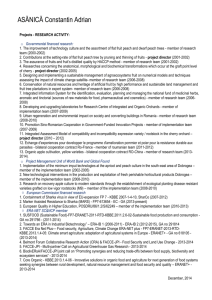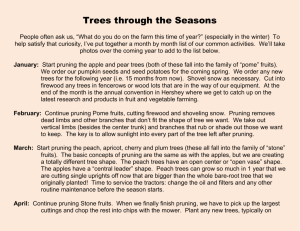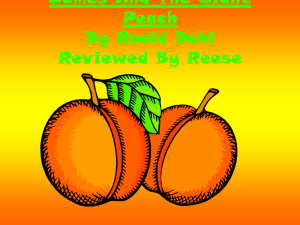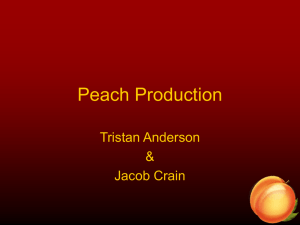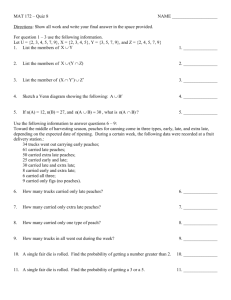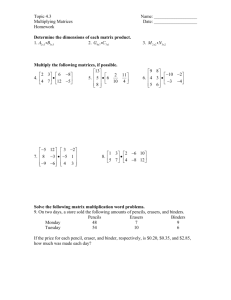NECTARINES
advertisement
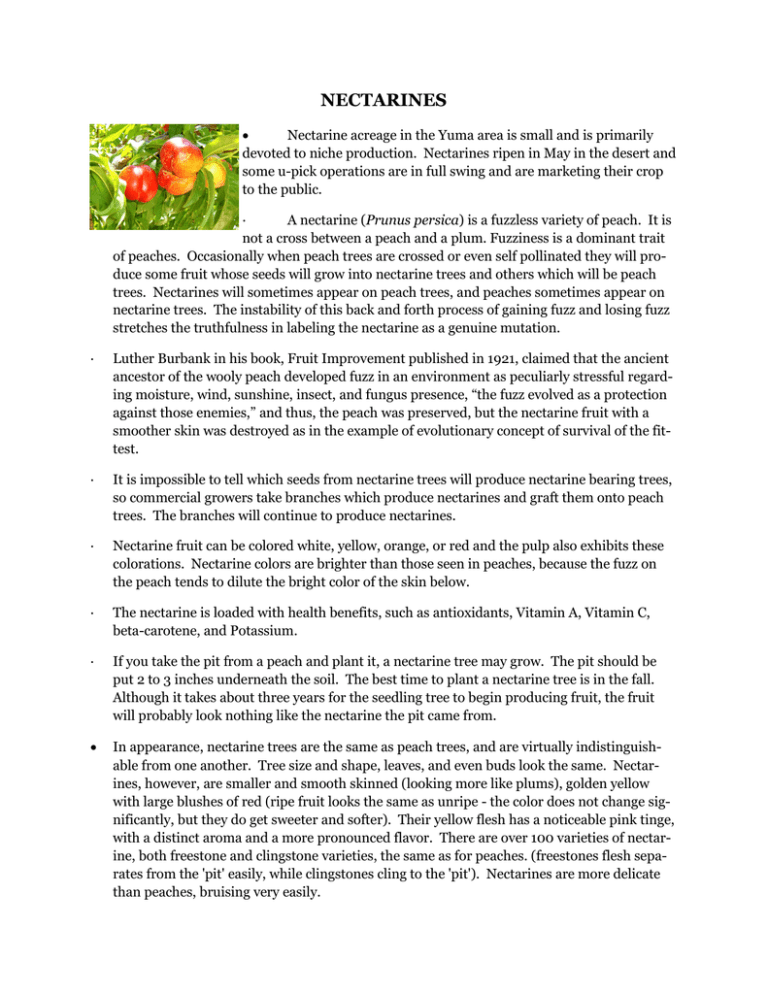
NECTARINES Nectarine acreage in the Yuma area is small and is primarily devoted to niche production. Nectarines ripen in May in the desert and some u-pick operations are in full swing and are marketing their crop to the public. · A nectarine (Prunus persica) is a fuzzless variety of peach. It is not a cross between a peach and a plum. Fuzziness is a dominant trait of peaches. Occasionally when peach trees are crossed or even self pollinated they will produce some fruit whose seeds will grow into nectarine trees and others which will be peach trees. Nectarines will sometimes appear on peach trees, and peaches sometimes appear on nectarine trees. The instability of this back and forth process of gaining fuzz and losing fuzz stretches the truthfulness in labeling the nectarine as a genuine mutation. · Luther Burbank in his book, Fruit Improvement published in 1921, claimed that the ancient ancestor of the wooly peach developed fuzz in an environment as peculiarly stressful regarding moisture, wind, sunshine, insect, and fungus presence, “the fuzz evolved as a protection against those enemies,” and thus, the peach was preserved, but the nectarine fruit with a smoother skin was destroyed as in the example of evolutionary concept of survival of the fittest. · It is impossible to tell which seeds from nectarine trees will produce nectarine bearing trees, so commercial growers take branches which produce nectarines and graft them onto peach trees. The branches will continue to produce nectarines. · Nectarine fruit can be colored white, yellow, orange, or red and the pulp also exhibits these colorations. Nectarine colors are brighter than those seen in peaches, because the fuzz on the peach tends to dilute the bright color of the skin below. · The nectarine is loaded with health benefits, such as antioxidants, Vitamin A, Vitamin C, beta-carotene, and Potassium. · If you take the pit from a peach and plant it, a nectarine tree may grow. The pit should be put 2 to 3 inches underneath the soil. The best time to plant a nectarine tree is in the fall. Although it takes about three years for the seedling tree to begin producing fruit, the fruit will probably look nothing like the nectarine the pit came from. In appearance, nectarine trees are the same as peach trees, and are virtually indistinguishable from one another. Tree size and shape, leaves, and even buds look the same. Nectarines, however, are smaller and smooth skinned (looking more like plums), golden yellow with large blushes of red (ripe fruit looks the same as unripe - the color does not change significantly, but they do get sweeter and softer). Their yellow flesh has a noticeable pink tinge, with a distinct aroma and a more pronounced flavor. There are over 100 varieties of nectarine, both freestone and clingstone varieties, the same as for peaches. (freestones flesh separates from the 'pit' easily, while clingstones cling to the 'pit'). Nectarines are more delicate than peaches, bruising very easily. · Nectarine cultivars do not require cross pollination and set satisfactory crops with their own pollen. A single peach or nectarine tree can, therefore, be expected to bear crops if flower flowers are not killed by low temperatures. · Nectarines, like peaches, probably originated in China over 2,000 years ago and were cultivated in ancient Persia, Greece and Rome. They were grown in Great Britain in the late 16th or early 17th centuries, and were introduced to America by the Spanish. · The word 'nectarine' means sweet as nectar, and this is very likely the obvious origin of the name. · When ripe, the nectarine's smooth skin is a brilliant golden yellow with generous blushes of red. Nectarines are wonderful eaten out of hand and can be used in salads, a variety of fresh and cooked desserts and as a garnish for many hot and cold dishes. Usually, nectarines are smaller than peaches and have more red color on the surface, and more aromas. · Popular uses for peaches and nectarines include fresh eating, sugared, and with cream. They are also used in ice cream, pies, cobbler, and shortcake. In addition, peaches and nectarines are used for jam, jelly, preserves, and mixed fruit desserts. · Nectarines can be used in the same ways as peaches, except if someone peels a peach because they object to eating the fuzz, they do not need to peel a nectarine. The nectarine skins can also be left on when making pies, cobblers and fresh fruit salads, etc. If buying fruit to eat the same day, it’s best to look for fruit that is soft, gives to gentle palm pressure, and has a sweet aroma. It’s easy to ripen firm peaches or nectarines. Place the fruit in a paper bag, fold the top over loosely, and keep at room temperature for 1-3 days. Check the fruit daily. Once fruit is soft or ripe it can be stored in the refrigerator for a week or more. · Nectarines are usually smaller than peaches and have a sweet, succulent flavor with a firmer texture. They are a brilliant golden yellow with blushes of red. Their flesh is yellow with a pink tinge. There are over 100 varieties of nectarine, including the white nectarine. · One Chinese emperor so loved the nectarines that he and his people referred to them as the "nectar of the gods". The word nectarine means "sweet as nectar". Kurt Nolte is an area agriculture agent with the Yuma County Cooperative Extension. He can be reached at 928-726-3904.
